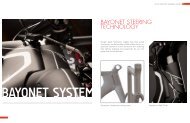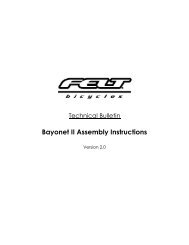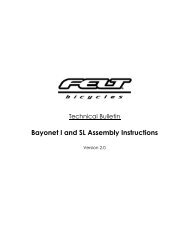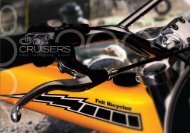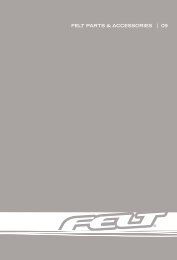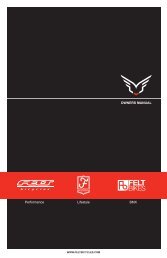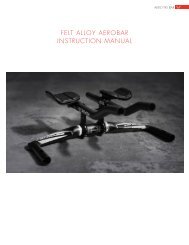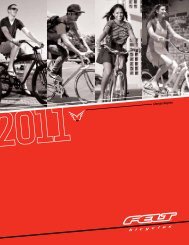06 Road - Felt Bicycles
06 Road - Felt Bicycles
06 Road - Felt Bicycles
Create successful ePaper yourself
Turn your PDF publications into a flip-book with our unique Google optimized e-Paper software.
THE FELT GEOMETRY PHILOSOPHY<br />
If “Semi-Compact” geometry sounds a little too close to high school math homework to<br />
understand, think again.<br />
For many years there was really only one style of geometry available. Based on the<br />
European styles of the 70’s and 80’s, little thought was given to the reasons for buying a bicycle<br />
other than for racing. In essence, this meant large double-diamond designs with horizontal<br />
(sometimes even reverse-sloping) top tubes, which often resulted in heavy frames and subdued<br />
stiffness. Regardless, this look remains tremendously attractive to today’s cyclist. Let’s call this<br />
“traditional” geometry.<br />
In recent years, several companies have adopted the notion of “compact” geometry. Compact<br />
geometry means that they take the same seat and head tube angle, down tube and chain stay<br />
length as traditional geometry, but utilize a shorter seat tube. As a result, the bike has shorter seat<br />
stays, a longer top tube and, more often than not, a shorter head tube. This means that the bike<br />
has a lower stand-over height, but it is necessary to run an ultra-long seat post, which can cause<br />
additional flex and result in a less stiff ride than one might assume in a smaller, seemingly lighter<br />
frame. In addition, compact geometry means that only a few sizes need to be made, so sizing may<br />
also be an issue if the bike runs in more than the standard 2cm increments.<br />
<strong>Felt</strong> took the benefits of the more desirable stand-over height and weight of the compact<br />
frame and married it to the enduring look of a traditional geometry bicycle. <strong>Felt</strong>’s “semi-compact”<br />
geometry is the ultimate blend between the look and size range of a traditional horizontal top<br />
tube frame, with the increased stiffness to weight ratio of a smaller, compact frame. Since this<br />
ultimately looks different from a traditional road bike, the “effective top tube length” is published<br />
in order that comparisons can be made between the different styles of bikes on the market.<br />
Since the frames are indeed smaller than traditional frames, maintaining the classic look of a<br />
horizontal top tube and the proper handlebar height of traditional geometry is achieved simply<br />
by using a positive-rise handlebar stem rather than a negative-drop stem.<br />
Most models are available in eight sizes (47, 50, 52, 54, 56, 58, 60, 63cm), among the widest of<br />
ranges on the market, so riders can find the perfect fit. For sizes 54, 56, 58, 60, 63cm, frames are<br />
measured from the center of bottom bracket to the top of the seat tube. We then provide a top<br />
tube length that is proportionate to the “size” of the frame. [Translation: a 56cm frame also has a<br />
56cm top tube].<br />
On frame sizes 47, 50, 52cm, we actually reduce the seat tube length 2-3cm below the numeric<br />
“size” call-out on the frame [Translation: a 50cm frame actually measures about 48cm from center<br />
of BB to the top of the seat tube]. This provides a gently sloping top tube, to better fit the standover<br />
height requirements of smaller riders.<br />
51




